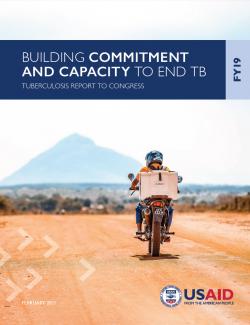Building Commitment and Capacity to End TB
Tuberculosis: The World’s Deadliest Infectious Disease
Tuberculosis (TB) is the world’s leading infectious-disease killer. In Calendar Year 2019, TB took the lives of an estimated 1.4 million—more than HIV and malaria combined— and sickened an estimated ten million people.
Across the globe, millions of people suffer and die from this disease each year due to a range of factors including lack of access to services; lack of innovative tools to address the disease; weak health care and laboratory infrastructure; the challenges of diagnosing; difficulties administering and receiving treatment for drug-resistant TB (DR-TB); stigma and discrimination; and high risk of co-morbidities. Early identification of individuals with TB, and immediately ensuring their access to effective treatment, remains a global challenge and is essential for preventing further transmission.
TB also hinders development and prosperity in low and middle-income countries around the globe. TB disproportionately affects the poorest populations, and further drives individuals and families into poverty. On average, TB patients and their households lose 50 percent of their annual incomes as they suffer from, and receive treatment for, the disease—even where TB services are provided free of charge.2 In addition, those with TB experience isolation, stigma, discrimination, and the fear of transmitting the disease to loved ones.
Many people with TB have other health issues that further exacerbate their situations. Malnourishment, smoking, alcohol abuse, HIV infection, and diabetes are high-risk comorbidities for TB. More than 2.2 million people with TB are undernourished, making it difficult for them to complete treatment successfully.3
In 2019, the estimated TB cases reported to National TB Programs (NTPs) increased slightly, with 71 percent of global estimated cases reported (as compared to 70 percent in 2018).4 Globally in 2019, only 57 percent of the 5.9 million pulmonary TB cases were bacteriologically confirmed (the rest were clinically diagnosed).5 This was a slight increase from 55 percent in 2018, but the proportion has remained almost unchanged since 2005. For comparison, in highincome countries, on average, 84 percent of pulmonary cases were bacteriologically confirmed.6 Further, only 58 percent (two million) of those bacteriologically confirmed cases globally were detected using the internationally recommended rapid diagnostic test.7
It is concerning that increases in notifications in high-TB-burden countries from 2018 to 2019 were associated with a decrease in the proportion of cases that were bacteriologically confirmed. To avoid both missed diagnoses of people who have TB and overtreatment of people who do not have TB, greater efforts are needed to both improve the availability and use of the most sensitive diagnostic tests for TB (such as molecular diagnostic tests) and ensure that international standards for TB care are met. As countries intensify efforts to close gaps between incidence and notifications, bacteriological confirmation of TB cases needs to be monitored to ensure that people are correctly diagnosed and started on the most effective treatment. The aim should be to increase the percentage of cases confirmed bacteriologically.

